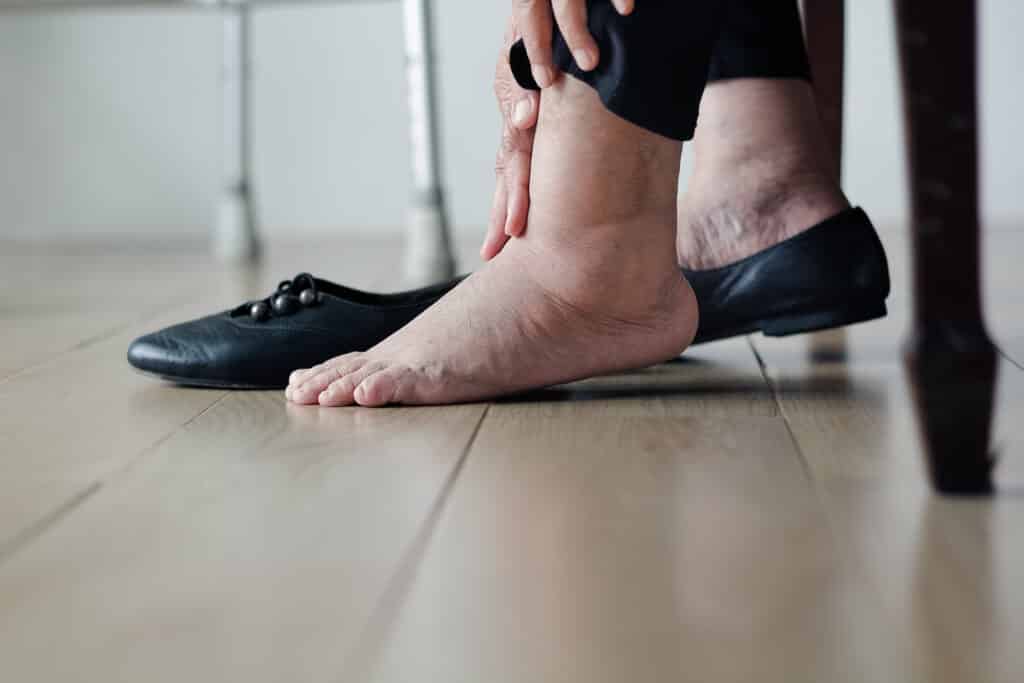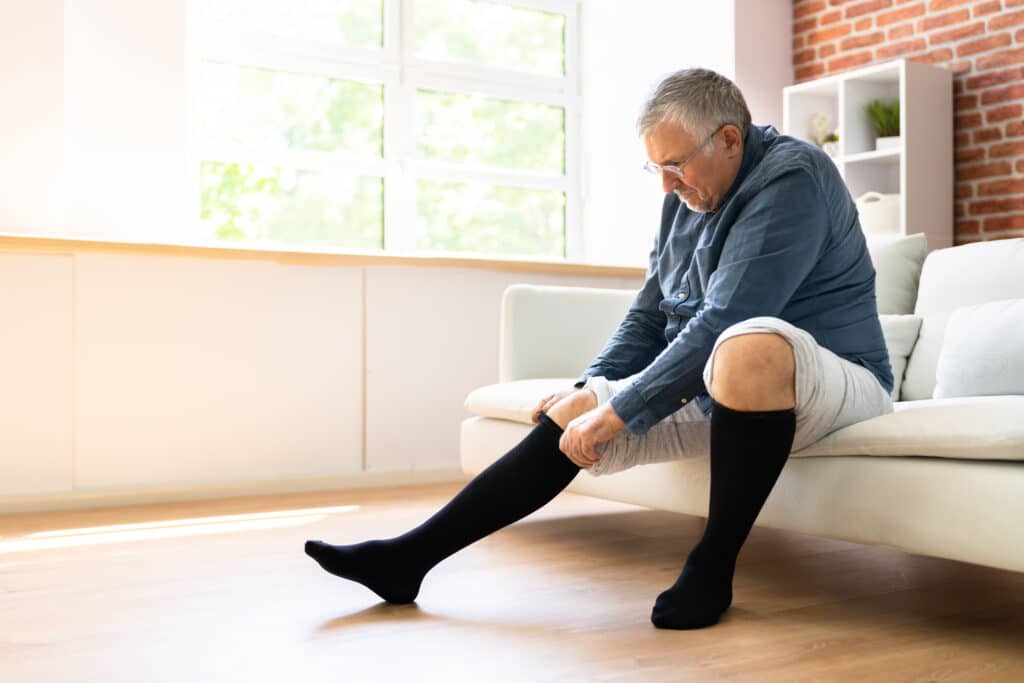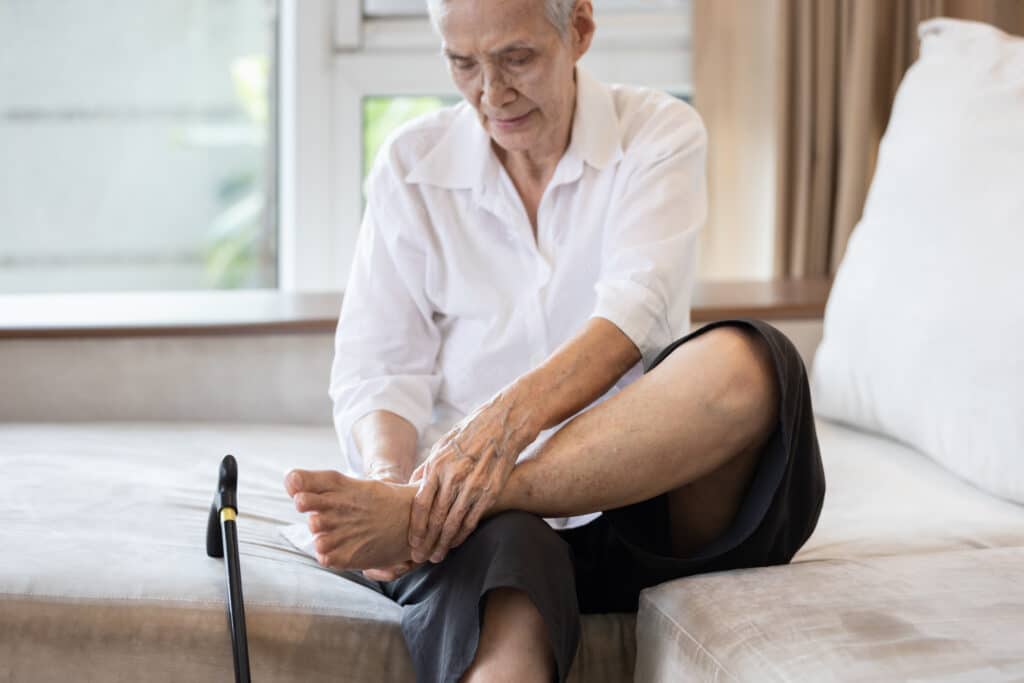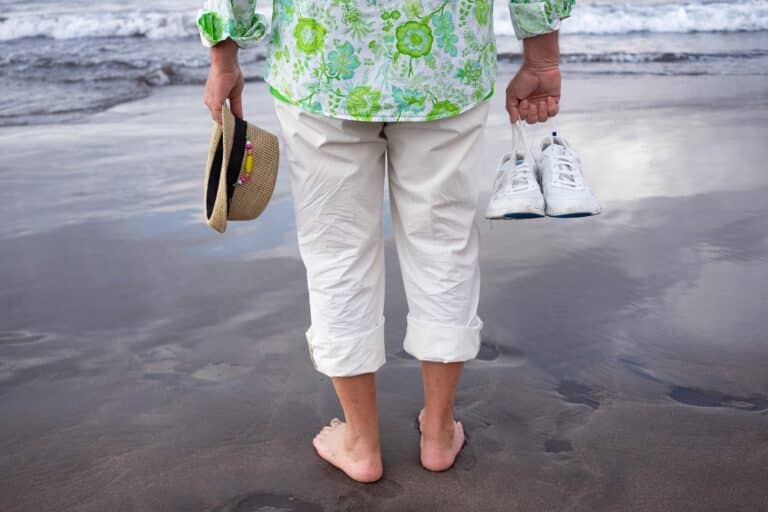Have you ever tried putting on your shoes and felt they were tighter than usual or didn’t fit anymore? Or have you noticed a strong indentation in your skin left behind from your socks when taking them off at the end of the day?
Swollen legs, ankles, and feet can be anxiety-provoking when you don’t know the cause. Persistent lower extremity swelling can indicate various underlying issues and can be particularly pronounced in the lower legs due to gravity.
There are several different factors that can cause this type of swelling. Excessive sodium or alcohol intake, prolonged time on your feet, or a sedentary lifestyle commonly play a role in this condition. Whatever the origin, it is essential to find the root cause of the swelling and address it.
Foot and ankle swelling can develop for many reasons, and it causes discomfort for many seniors. Thankfully, there are several things you can do at home to get your edema under control.
An Overview of Swelling in the Ankles and Feet
Edema is caused by excess fluid in the body’s tissues. A specific type of edema, peripheral edema, refers to moderate-to-severe swelling of the extremities, especially the lower legs, ankles, and feet.
Many different bodily systems help to manage the balance of fluids in the different parts of the leg. When any of these systems are strained or dysfunctional, it can cause fluid buildup.
It is important to identify the causes of edema if you notice an accumulation of fluid in your lower legs.
Your body can accommodate two to three liters of fluid before you notice any “pitting” edema. “Pitting” means that when you press a finger into the swollen area, it leaves behind an indentation or “pit” that takes multiple seconds or even minutes to bounce back.
The cause of this type of swelling can be serious and can be a precursor to heart or liver failure. Consult your doctor immediately to identify a diagnosis and appropriate treatment plan.
Once a treatment plan has been put in motion, or your lower extremity edema is not connected to an underlying disease, you can begin to reduce swelling.
In my clinical practice, I usually recommend treatments that include exercise, compression stockings, and elevating one’s legs to decompress the swollen areas.
Each case of edema is different; let’s look closely at some causes and how these treatments can help.
Causes of Swelling (Edema) in the Ankles & Feet

Lifestyle Factors
Lifestyle factors that can cause edema in ankles and feet include prolonged time on your feet or seated, weather conditions, or poor diet.
Either standing or sitting in a stagnant position can lead to swelling. This can result from what you do for work (a teacher or nurse) or how you spend your free time (like gaming at a computer — a passive activity).
Standing or sitting still in a single position causes an accumulation of fluid in your ankles due to the effects of gravity. Keeping your legs in any continuous position for too long makes it hard for your lymph drainage system to work to get that fluid out.
Impact of Weather on Edema
Temperature plays a crucial role in edema. Heat causes blood vessels to expand, leading to fluid leakage and swelling, especially in ankles and feet. In cold weather, circulatory strain can also lead to swelling.
Managing edema in extreme temperatures involves staying cool and hydrated in the heat and keeping warm with good circulation in the cold. Consult your healthcare provider for advice tailored to specific weather conditions and individual health.
Sodium’s Role in Edema
Other lifestyle factors, such as a diet high in salt or alcohol, can also increase lower extremity swelling.
Excessive sodium intake is a major dietary factor in edema. Sodium causes the body to retain water, leading to swelling.
Reducing sodium in table salt and processed foods and staying hydrated can alleviate edema symptoms. A balanced diet low in sodium and rich in fruits, vegetables, and lean proteins helps maintain fluid balance. For personalized dietary management, consult a nutritionist.
Medical Causes
Multiple medical conditions may result in leg swelling. Regardless of the cause, keeping symptoms like edema in check is essential for disease management.
These conditions include but are not limited to heart failure, liver failure, kidney failure, chronic venous insufficiency, lymphedema, and, for younger patients, pregnancy. Fluid overload is among the most common reasons for heart failure hospitalizations.
In some cases, edema can also be a side effect of medication, so adjustments to your medication schedule might be helpful.
Rather than making assumptions about the cause of your swelling, it’s always best to leave the diagnosis to your medical provider to ensure you get the treatment necessary.
DVT and Its Affect on Edema
Deep Vein Thrombosis (DVT), where blood clots form in deep veins, often leads to swelling, typically in one leg. It poses risks like pulmonary embolism and requires immediate medical attention.
Risk factors include prolonged immobility, certain medical conditions, and some medications. Treatment usually involves anticoagulants and possibly compression stockings. If experiencing unexplained or asymmetric leg swelling, seek medical evaluation promptly to rule out DVT.
Symptoms of Edema in the Lower Leg
Swelling in the ankles and feet can cause skin stretching, a shiny skin appearance, and a tighter fit for shoes and socks. Other symptoms that can accompany the swelling include stiffness, pain, redness, and skin temperature changes.
The increased size and shape of the limbs can result in stiffness, which may cause a decreased range of motion. Stiff limbs might make squatting down or putting on your shoes and socks more difficult.
In extreme cases, the area may also be painful. The leg may be warm or red if the swelling is due to injury or infection. On the other hand, the limbs may be cool to the touch if circulation is impacted, often due to poor blood flow or constriction of blood vessels.
I remind my patients that any temperature changes in the leg require a visit to their doctor for further testing to ensure that there is no more serious condition at work.
Diagnosis of Edema
Diagnosing edema in the ankles and feet typically involves a combination of physical examination, medical history analysis, and imaging tests.
During a physical exam, a healthcare provider will likely begin by examining the affected area and checking for swelling, pitting, redness, warmth, or tenderness. They will also check for other signs of underlying medical conditions that can cause edema, like heart or kidney disease.
Your physician will also ask about your medical history, including any medications you are taking, recent injuries or surgeries, and any family history of edema or related medical conditions. Keeping an accurate and up-to-date list of your medications is crucial to ensure that drug combinations or side effects are not the cause.
In some cases, imaging tests may be necessary to help diagnose any underlying causes of edema. These might include X-rays, ultrasounds, or MRIs.
- X-rays can help rule out other conditions, such as fractures or arthritis.
- Ultrasound or Doppler scans can be used to check for blood clots, which can cause edema in the legs.
- Magnetic resonance imaging (MRI) can detect soft tissue damage or infections as a potential culprit. (3)
Common Edema Treatments

In some cases, treatment may involve a combination of approaches. Frequently, if the edema is mild or moderate, the first line of defense is targeted lifestyle change.
In cases of severe edema, treatment may include medications or surgical procedures.
I like to remind my patients that various methods are available to manage their swelling at home. Commonly recommended lifestyle changes may include getting more exercise, using compression stockings, dietary changes, or simply elevating the legs to find relief.
Elevate Your Legs
As a temporary solution, keeping your legs elevated higher than the heart can help combat fluid retention, allowing the fluid to flow back to the center of your body.1
As the edema dissipates, fluids get redistributed to other areas. Some fluids will also be sent for elimination, meaning more bathroom trips than usual.
Compression Stockings
Compression stockings are an excellent solution for older adults with less effective venous systems and people who spend prolonged time on their feet.
These stockings — or socks — can help fluid return through the lymphatic system to promote normal functioning. They provide external pressure to push fluid from the ankles and legs. You may also find benefits from walking with the stockings on.
I typically offer my patients the following simple tips for getting the most out of compression stockings:
- Ensure that the stockings you get are fitted to your leg size — you do not want them to be too tight at the top to where they create a tourniquet.
- Ensure there are no wrinkles in the stockings. Check your skin for any pressure points or areas of redness after wearing them.
- Take the socks off at night so your skin can breathe, and do not wear them over any open wounds.
Dietary Changes
Dietary changes to decrease edema include reducing sodium intake and avoiding excessive alcohol consumption. Although these aspects of your diet are rarely the sole cause of edema, controlling the amount of salt and alcohol in your diet can help to reduce leg swelling.
Alongside dietary changes, your doctor may prescribe diuretics to help you offload extra fluid.
Though effective, diuretics increase the amount of urine you produce, so you may need to get up to go to the bathroom more often. Remember that it is still essential to stay hydrated by drinking water while taking diuretics.
Other Clinical Treatments
In severe cases of lymphedema (or edema causing swelling in the lymph nodes and other tissues from a compromised lymphatic system), a more complex and specialized procedure can bypass a blockage by redirecting the fluid.
Techniques utilizing pneumatic pumps, complex bandaging, or surgery may be recommended in rarer, more serious cases. Talking to your doctor to determine the right treatment options to treat your edema is critical.
If you are dealing with a foot and ankle still swollen after a month, it’s best to talk to a medical professional or seek physical therapy for edema.
Exercises for Edema
Exercise, especially when it involves repetitive movement in the lower legs, can also help aid fluid return. The consistent contraction of your leg muscles during a workout can help squeeze the fluid up and out of the legs and feet.
Here are some simple at-home exercises you can try to manage edema. Remember that these exercises can be done multiple times throughout the day as you learn how to manage this condition.
Ankle pumps and ankle circles
- Lying on your back with your legs elevated, pull your toes toward your head, moving at the ankle. Follow this up by pointing your toes away from your head.
- Alternatively, you can try “drawing” circles in the air using only your ankles, doing equal repetitions in both directions.
- Perform either of these movements relatively quickly back and forth at least 30 times.
Seated kicks
- Begin seated upright in a chair with back support, with feet flat on the floor.
- Extend one leg straight with a slow kicking motion. Keep your ankle flexed, pulling your toes toward your nose.
- Slowly lower it down until it rests. Repeat on the other side.
- Perform around 15-20 times on each leg.
Supine marches
- Lying flat on your back with your legs supported, bend one knee toward your chest until you feel a stretch in the knee and ankle.
- Slowly return the leg to the start position and repeat with your other leg.
- Repeat this exercise around ten times on each leg.
Lymphatic drainage self-massage
- Using your hands or an instrument such as a tennis ball, perform light massaging movements around the affected area. It is important to start at the toes and work up the leg.
- Using soft massage strokes, gently guide the fluid up the leg toward the heart. After massaging the toes and foot for a few minutes, move up toward the ankle, then progress up the lower leg to the knee.
- Take your time, and move slowly and gently. Move on to the other leg when you are ready.
With its focus on medically sound exercise, physical therapy can help with edema, especially if you’re unsure where to start or have a more extreme case of edema.
Key Takeaways
You can often manage edema symptoms primarily at home through activity modification, lifestyle adjustments, and exercise, but your doctor’s assessment of the cause is vital to finding relief. Here are some takeaways from what we have covered:
- Understanding Edema: Edema results from fluid buildup in body tissues, often intensified in the lower legs by lifestyle factors such as prolonged standing or sedentary habits.
- Indicators of Underlying Conditions: “Pitting” edema can signal severe conditions like heart or liver failure, making timely diagnosis crucial.
- Combating Swelling: Exercise, leg elevation, and compression stockings are primary methods to manage and reduce edema at home.
- Diverse Causes: Both lifestyle choices and medical conditions, ranging from dietary habits to heart failure, can instigate swelling.
- Symptoms and Diagnosis: Besides visible swelling, symptoms can encompass skin stretching, tightness in footwear, and temperature changes. Diagnosis typically involves physical exams and sometimes imaging tests.
- Role of Diet and Stockings: Adjusting dietary habits and using well-fitted compression stockings can help to alleviate symptoms.
- Always Seek Expertise: Persistent or uncertain swelling warrants consultation with a medical professional for proper guidance.
FAQs
How long does swelling usually last with appropriate treatment?
The duration of swelling depends on its cause. If it’s due to prolonged standing or a minor injury, it may subside in a few days with proper rest and care. However, it may require more extended treatment or ongoing management if it’s linked to medical conditions, such as heart issues. Always consult a doctor to get a clear understanding of your specific case.
How long should compression stockings be worn each day?
Compression stockings should generally be worn during waking hours and removed at bedtime. The exact duration can vary based on the severity of the swelling and medical advice. Some individuals might wear them for shorter periods, especially when they expect prolonged standing, while others might benefit from all-day use. Ensure they fit correctly, and regularly check for any signs of skin irritation.
Can weight gain worsen swelling?
Yes, being overweight can worsen swelling. Excess weight can exert pressure on your veins, impeding proper blood flow and leading to edema. Furthermore, obesity can contribute to other health issues that might induce swelling. Thus, maintaining a healthy weight can help mitigate this condition.
Can weather conditions, such as extreme heat or high altitudes, aggravate swelling?
Absolutely. Extreme heat can cause blood vessels to dilate, leading to increased swelling. Similarly, the heart may work harder at higher altitudes where oxygen is scarcer, potentially exacerbating swelling, especially for those with cardiac conditions. It’s advisable to remain cool during hot days and to exercise caution when transitioning to higher altitudes.
Are there specific shoes recommended for individuals with foot and ankle swelling?
Yes, footwear can play a role in managing swelling. Shoes that offer arch support, spacious toe area, and good ventilation can be beneficial. Avoid high heels or ill-fitting shoes. If swelling is significant, consider specialty shoes or orthotic inserts. When shopping for shoes, it’s best to do so later in the day when feet are naturally at their largest.
Resources:
- Goyal A, Cusick AS, Bhutta BS. Peripheral Edema. [Updated 2023 Feb 9]. In: StatPearls [Internet]. Treasure Island (FL): StatPearls Publishing; 2023 Jan-. Available from: https://www.ncbi.nlm.nih.gov/books/NBK554452/
- Fu, M. R., Li, Y., Conway, C., Masone, A., Fang, J., & Lee, C. (2022). The Effects of Exercise-Based Interventions on Fluid Overload Symptoms in Patients with Heart Failure: A Systematic Review and Meta-Analysis. Biomedicines, 10(5), 1111. https://doi.org/10.3390/biomedicines10051111
- Gasparis, A. P., Kim, P. S., Dean, S. M., Khilnani, N. M., & Labropoulos, N. (2020). Diagnostic approach to lower limb edema. Phlebology, 35(9), 650–655. https://doi.org/10.1177/0268355520938283
- Carvalho, C. A., Lopes Pinto, R., Guerreiro Godoy, M.deF., & Pereira de Godoy, J. M. (2015). Reduction of Pain and Edema of the Legs by Walking Wearing Elastic Stockings. International journal of vascular medicine, 2015, 648074. https://doi.org/10.1155/2015/648074





